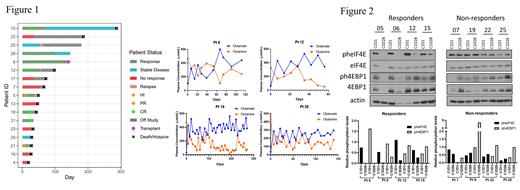Background: Ven-based therapies have been an advancement in the front-line treatment of AML; however development of resistance is common and the efficacy of Ven-containing regimens in R/R AML has been far less promising. We reported in vitro and in vivo depletion of Gln induced by long-acting Erwinia asparaginase, PegC, inhibited proliferation of complex karyotype (CK) AML and synergistically enhanced the antiapoptotic activity of Ven-mediated antagonism of Bcl-2 by decreasing the expression of proteins such as Mcl-1, whose translation is cap-dependent. Here we report the final results of our phase 1 clinical trial (NCT04666649) of VenPegC for treatment of R/R AML including patients (pts) previously treated with Ven.
Methods: Pts received Ven 400 mg on D1-28 and PegC (500, 750, 1000 IU/m 2 in cohorts 1-3, IV) D1 & D15 every 4 weeks (wk). Primary study endpoints were incidences of regimen limiting toxicities (RLT) and RP2D. Secondary endpoints included rate of composite complete remissions. Correlative studies included monitoring plasma amino acid levels and asparaginase activity, and expression of proteins regulating cap-dependent mRNA translation in bone marrow (BM) mononuclear cells pre- and post-VenPegC treatment.
Results: As of July 31, 2023, 26 pts were enrolled of whom 24 received at least 1 dose of PegC and 17 completed at least 1 cycle of PegC (2 doses). The median age was 61 (range 24-79), 16 (62%) were female; 9 (35%) had CK-AML and 5 (19%) had TP53 mutations; 18 (69%) were previously treated with Ven. Median prior lines of treatment were 2 (range 1-5). No RLT was observed in cohort 1 (n=3). Cohort 2 was expanded to 6 pts due to transient asymptomatic hypertriglyceridemia. Two pts in cohort 3 (n=3) developed grade 3 hyperbilirubinemia determined as RLT. Expansion cohort included 11 pts who were treated at MTD/RP2D (PegC 750 IU/m 2 plus Ven 400 mg) given as out-pt without a need for hospitalization. No pancreatitis, thrombohemorrhagic events, or silent inactivation were observed in the entire study population.
Overall response rate (ORR) for pts who received ≥1 cycle of PegC was 47% (8/17), Fig 1. CR+ CRh+CRi rate was 29% (5/17); 1 pt had a partial remission with full count recovery and is currently receiving cycle 6; 2 pts had stable disease. Four pts showed hematologic improvement. Twelve (71%) pts who received ≥1 cycle of PegC were previously treated with Ven and were Ven-refractory. ORR in Ven-refractory pts was 42% (5/12); of the 5 pts who harbored a RAS or PTPN11 mutation and previously treated with Ven, 60% responded.
Remarkably, all pts (3/3) who had a RUNX1 mutation achieved a CR; Pt 6 (relapsed AML with NRAS/cKIT/RUNX1 mutations) achieved an MRD-negative CRh and underwent an allogeneic stem cell transplant (alloHSCT); Pt 12 (primary refractory AML with TP53/NRAS/RUNX1 mutations) achieved a clearance of BM blasts after 1 dose of PegC and achieved MRD-negative CR at the end of cycle 1, and Pt 15 (post-alloHSCT relapsed AML with NRAS/PTPN11/CSF3R/RUNX1 mutations) achieved a CRi and received 10 cycles of VenPegC. Pt 31 (post-alloHSCT relapsed AML with FLT3-ITD) who had persistent disease after gilteritinib achieved an MRD-negative CRi, pending 2 nd alloHSCT.
Nadir plasma asparaginase activity of >0.1 IU/mL was achieved in cycle 1 for all pts who received ≥1 cycle of VenPegC. All pts with available results achieved undetectable asparagine (Asn) level by day 7 and Asn remained undetectable throughout the study. Plasma Gln reduction from baseline occurred in all pts (except 1) within cycle 1. Pts in cohort 1 reached nadir Gln after initial PegC exposure in an average of 22 days compared to 16 days in cohort 2. In general, pts who achieved CR had the lowest absolute plasma Gln levels. Available Glu and Gln are shown in Fig.1 for pts who achieved a CR/PR.
Out of the 8 assessed pts (4 responders & 4 non-responders), VenPegC inhibited cap-dependent translation after 1 cycle in responders, as evidenced by decreased phosphorylated eIF4E (active, pheIF4E) in 4/4 pts and decreased phosphorylated 4EBP1 (inactive, ph4EBP1), a negative regulator of eIF4E, in 2/4 pts. Conversely, pheIF4E and ph4EBP1 expression was increased in 3/4 and 4/4 of the non-responders, respectively (Fig.2).
Conclusion: VenPegC is a novel regimen that can induce complete remission in some heavily pretreated R/R AML patients, even with previous exposure to Ven. Pts with RUNX1 mutation, whose translation depends on pheIF4E, may benefit further from this regimen.
OffLabel Disclosure:
Baer:Kite, a Gilead company (Inst): Research Funding; Ascentage Pharma (Inst): Research Funding; Takeda (Inst): Research Funding; FORMA Therapeutics (Inst): Research Funding; Kura Oncology (Inst): Research Funding; Abbvie (Inst): Research Funding. Emadi:Jazz Pharmaceuticals: Research Funding; NewLink Genetics: Research Funding; Amgen: Membership on an entity's Board of Directors or advisory committees, Research Funding; Servier: Research Funding; Kite Pharma: Consultancy, Membership on an entity's Board of Directors or advisory committees; Genentech: Membership on an entity's Board of Directors or advisory committees; Secura Bio: Consultancy; KinaRx, Inc: Membership on an entity's Board of Directors or advisory committees, Other: Co-founder.
Pegcrisantaspase in combination with venetoclax to treat acute myeloid leukemia.


This feature is available to Subscribers Only
Sign In or Create an Account Close Modal